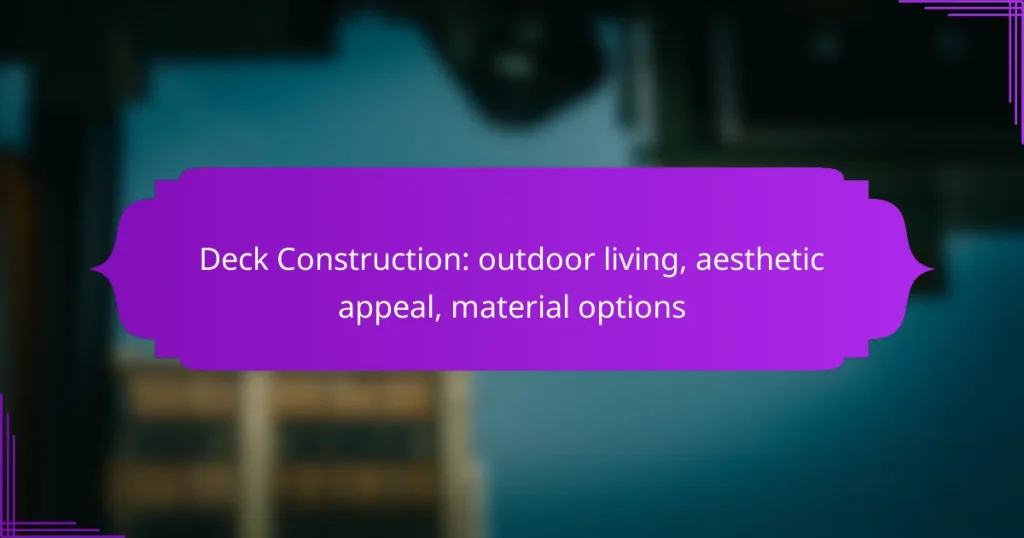Deck construction is an essential aspect of enhancing outdoor living spaces, providing both functional areas for relaxation and aesthetic appeal. With a variety of material options available, such as pressure-treated wood, composite decking, and aluminum, homeowners can choose the best fit for their budget and maintenance preferences. A thoughtfully designed deck not only complements your landscape but also elevates your overall outdoor experience.

What are the best materials for deck construction in Canada?
The best materials for deck construction in Canada include pressure-treated wood, composite decking, redwood and cedar, aluminum decking, and PVC decking. Each material offers unique benefits and considerations, depending on your budget, aesthetic preferences, and maintenance requirements.
Pressure-treated wood
Pressure-treated wood is a popular choice for deck construction due to its affordability and durability. It is treated with preservatives to resist rot and insect damage, making it suitable for the Canadian climate.
When using pressure-treated wood, consider regular maintenance such as sealing and staining to prolong its lifespan. Expect to replace boards every 10 to 15 years, depending on exposure to the elements.
Composite decking
Composite decking combines wood fibers and plastic, offering a low-maintenance alternative to traditional wood. It resists fading, staining, and warping, making it ideal for outdoor living spaces in Canada.
While composite decking can be more expensive upfront than wood, its longevity and minimal upkeep can save money over time. Look for products with warranties of 25 years or more to ensure quality.
Redwood and cedar
Redwood and cedar are natural woods known for their beauty and resistance to decay. They are often chosen for their rich colors and aromatic qualities, enhancing the aesthetic appeal of outdoor decks.
These woods require regular maintenance, including sealing and staining, to maintain their appearance and durability. Expect a lifespan of around 15 to 20 years with proper care.
Aluminum decking
Aluminum decking is a lightweight, durable option that is resistant to rust and corrosion. It is ideal for areas with heavy snowfall or moisture, as it does not absorb water.
While aluminum decking can be pricier than wood options, its longevity and minimal maintenance requirements make it a worthwhile investment. Look for products that come with a lifetime warranty for added peace of mind.
PVC decking
PVC decking is made entirely from plastic, offering excellent resistance to moisture, stains, and fading. It is a low-maintenance option that does not require sealing or staining, making it suitable for busy homeowners.
Although PVC decking can be more expensive than wood, its durability and long lifespan—often exceeding 25 years—make it a cost-effective choice in the long run. Ensure you choose high-quality brands to avoid issues with warping or fading.

How to choose the right deck design for outdoor living?
Selecting the right deck design for outdoor living involves assessing your lifestyle, available space, and how you want to integrate landscaping. A well-planned deck enhances your outdoor experience, providing a functional and aesthetically pleasing area for relaxation and entertainment.
Consider your lifestyle needs
Your lifestyle significantly influences the deck design you choose. If you frequently host gatherings, consider a larger deck with ample seating and dining space. For quieter, more personal use, a smaller, cozier design may suffice.
Think about the activities you enjoy. If you plan to use the deck for grilling or outdoor cooking, ensure there is enough space for a grill and prep area. Incorporating features like built-in seating or planters can enhance both utility and comfort.
Evaluate available space
Assessing the available space is crucial for a successful deck design. Measure your yard to determine how much area you can dedicate to the deck without overwhelming your landscape. A good rule of thumb is to ensure the deck occupies no more than 20-30% of your yard space.
Consider the layout of your home and how the deck will connect to it. A well-placed deck can create a seamless transition between indoor and outdoor living, enhancing both spaces. Ensure there is enough room for movement around furniture and features.
Incorporate landscaping elements
Integrating landscaping elements into your deck design can enhance its appeal and functionality. Use plants, flowers, and trees to create a natural ambiance that complements the deck. Consider using planters or built-in seating with greenery to soften hard surfaces.
Additionally, think about how lighting can enhance your deck and surrounding landscape. String lights, lanterns, or built-in LED fixtures can create an inviting atmosphere for evening gatherings. Ensure that any landscaping elements are suitable for your local climate and maintenance preferences.

What are the costs associated with deck construction in Canada?
The costs for deck construction in Canada can vary significantly based on materials, labor, and permitting fees. Homeowners should expect to budget anywhere from several thousand to over twenty thousand Canadian dollars, depending on the size and complexity of the project.
Material costs
Material costs for deck construction can range widely, typically falling between CAD 15 to CAD 50 per square foot. Common materials include pressure-treated wood, composite decking, and hardwoods, each with different price points and durability levels.
For example, pressure-treated wood is often the most economical option, while composite materials may have a higher upfront cost but offer lower maintenance over time. Consider the long-term value and upkeep when selecting materials.
Labor costs
Labor costs for deck construction in Canada generally range from CAD 30 to CAD 70 per hour, depending on the contractor’s experience and the project’s complexity. Some contractors may also charge a flat rate based on the total square footage of the deck.
When hiring a contractor, it’s crucial to obtain multiple quotes and check references to ensure quality workmanship. Be wary of significantly lower bids, as they may indicate subpar materials or rushed work.
Permitting fees
Permitting fees for deck construction can vary by municipality, typically ranging from CAD 50 to CAD 500. It’s essential to check local regulations, as some areas may require permits for any deck installation, while others may have size thresholds.
Obtaining the necessary permits before starting construction can prevent costly fines and project delays. Always consult with your local building authority to ensure compliance with zoning laws and safety standards.

What are the aesthetic trends in deck design for outdoor spaces?
Aesthetic trends in deck design for outdoor spaces emphasize natural beauty, functionality, and integration with the surrounding environment. Popular choices include natural finishes, multi-level structures, and integrated lighting, all of which enhance the visual appeal and usability of outdoor areas.
Natural finishes
Natural finishes in deck design focus on materials that blend seamlessly with the outdoor environment. Options like untreated wood, composite materials with wood-like textures, and stone can create a warm, inviting atmosphere. Consider using finishes that are weather-resistant to maintain the aesthetic over time.
When selecting natural finishes, look for sustainable sources to minimize environmental impact. For instance, using reclaimed wood not only adds character but also promotes eco-friendliness.
Multi-level decks
Multi-level decks add dimension and visual interest to outdoor spaces. They allow for distinct areas for dining, lounging, and gardening, making the space more functional. This design is particularly effective in sloped yards, where different levels can follow the natural terrain.
When planning a multi-level deck, ensure that each level has a clear purpose and is easily accessible. Incorporating steps or ramps can enhance safety and usability, especially for families with children or elderly members.
Integrated lighting
Integrated lighting is a key trend that enhances the ambiance of outdoor decks during the evening. Options include built-in LED lights along railings, steps, or under benches, providing both safety and aesthetic appeal. This lighting can create a cozy atmosphere for gatherings or quiet evenings outdoors.
When installing integrated lighting, consider energy-efficient options to reduce electricity costs. Solar-powered lights are a popular choice, offering flexibility and ease of installation without the need for electrical wiring.

What are the local regulations for deck construction in Canada?
In Canada, local regulations for deck construction vary by province and municipality, focusing on safety, zoning, and building standards. Homeowners must ensure compliance with these regulations to avoid fines and ensure structural integrity.
Building permits
Most municipalities in Canada require a building permit for deck construction, especially for larger or elevated decks. The application process typically involves submitting plans that detail the design, dimensions, and materials to be used.
Fees for building permits can range from a few hundred to over a thousand Canadian dollars, depending on the project’s scope and local regulations. Always check with your local building department to understand specific requirements and costs.
Zoning laws
Zoning laws dictate where and how you can build a deck on your property. These regulations may limit the size, height, and location of your deck, often requiring it to be a certain distance from property lines or bodies of water.
Before starting construction, verify the zoning bylaws in your area to avoid potential disputes or the need for modifications after the fact. Some municipalities may also have specific guidelines for decks in residential versus commercial zones.
Safety codes
Safety codes in Canada ensure that decks are built to withstand environmental factors and provide safe access. These codes cover aspects such as load-bearing requirements, railing heights, and materials used.
Familiarize yourself with the National Building Code of Canada and any local amendments that may apply. Adhering to these safety codes is crucial to prevent accidents and ensure the longevity of your deck.

How to maintain your deck for longevity?
To ensure your deck remains in good condition for years, regular maintenance is essential. This includes cleaning, sealing, and inspecting for damage to prevent costly repairs and enhance its aesthetic appeal.
Regular cleaning
Cleaning your deck regularly is crucial for maintaining its longevity and appearance. Aim to clean your deck at least once every season, using a gentle cleaner suitable for the material, whether it’s wood or composite.
For wooden decks, a mixture of water and mild soap can effectively remove dirt and grime. For composite materials, a specialized cleaner may be necessary to avoid discoloration. Use a soft-bristle brush or a pressure washer on a low setting to avoid damaging the surface.
Don’t forget to remove debris such as leaves and dirt, as these can trap moisture and lead to mold growth. A quick sweep or rinse can go a long way in preserving your deck’s integrity.


